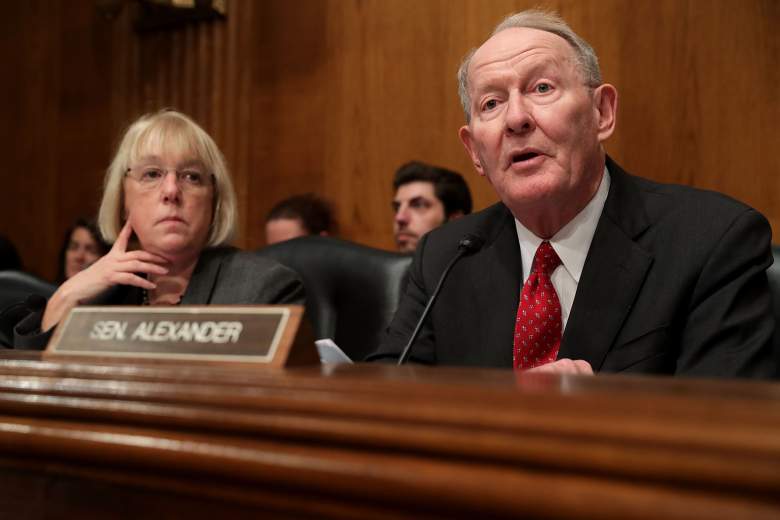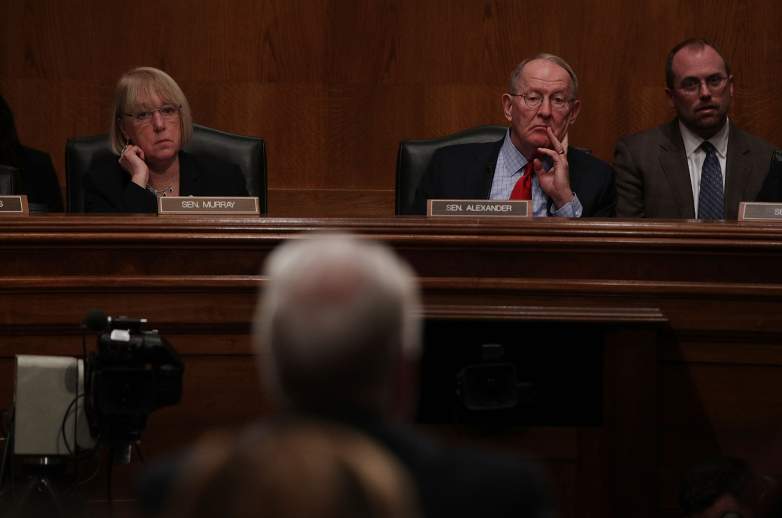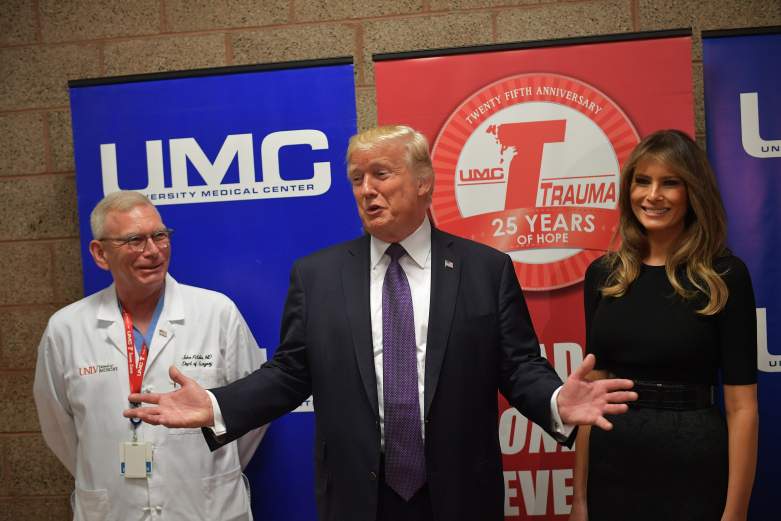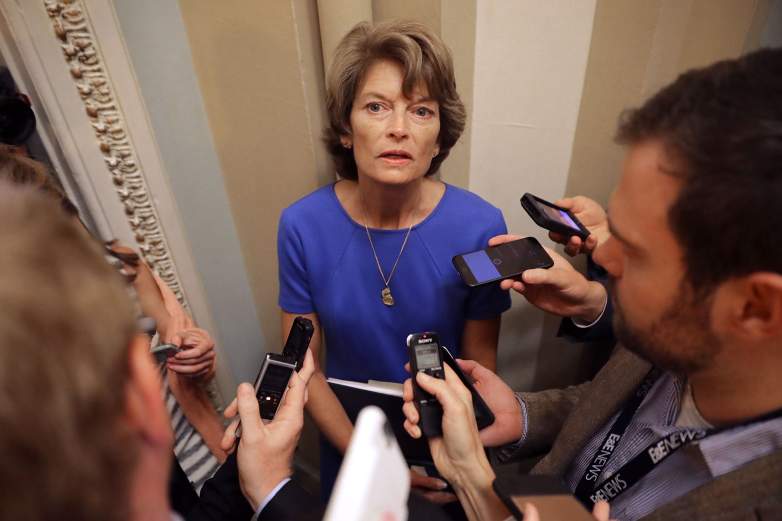
President Donald Trump has indicated his support for a bipartisan healthcare deal sponsored by Sens. Patty Murray, D-Wash., and Lamar Alexander, R-Tenn., that would act as a temporary stopgap while Congress continues to debate Obamacare reform.
“This would allow the Senate to continue its debate about the long term of health care, but over the next two years I think Americans won’t have to worry about the possibility of being able to buy insurance in counties where they live,” said Alexander after presenting the bill to fellow Republican senators in a closed-door lunch.
“This agreement avoids chaos. I don’t know a Republican or Democrat who benefits from chaos,” the senator added.
Supporters have called the bill a bipartisan solution to the destabilization of the Obamacare healthcare markets of which experts warned after Trump made massive cuts to insurer subsidies last week.
Here’s what you need to know:
-
1. Sens. Lisa Murkowski (R) & Tim Kaine (D) Say They Will Cosponsor the Bill
-

GettySen. Lisa Murkowski (R-AK) talks with reporters before attending the weekly Senate Republican policy luncheon outside the Mansfield Room at the U.S. Capitol July 18, 2017 in Washington, DC.
Senate heavyweight Tim Kaine, D-Va., has thrown his support behind the bill, telling Axios on Wednesday that he expected it to “pass as some part of a must-pass piece of legislation” rather than as a stand-alone bill.
The senator predicted that Alexander-Murray would get tacked onto the federal spending bill in December.
Senator Lisa Murkowski, R-Alaska, who was a key figure in killing Graham-Cassidy, an earlier Republican attempt at gutting Obamacare, has also signaled her support for Alexander-Murray.
“I applaud my colleagues, Sens. Alexander and Murray, for continuing to work toward a bipartisan solution addressing some of the most urgent and pressing needs when it comes to the flawed current health care law,” she said in a press release.
The senator added, “This short-term deal is an important step as we work towards long-term solutions. So many of us agree the status quo with healthcare in this country is unacceptable. We must continue our efforts to reform our healthcare system – by reducing costs, increasing access, and providing quality healthcare that Americans deserve.”
MSNBC correspondent Garrett Haake tweeted Wednesday morning that the Kaine and Murkowski plan on cosponsoring the bill, according to their respective offices.
2. It Is a Bipartisan Bill With Support From Both Sides of the Aisle, but Has Drawn Criticism From Far-Right Legislators

GettyCommittee chairman Sen. Lamar Alexander (R-TN) (2nd L) and ranking member Sen. Patty Murray (D-WA) (L) listen during a confirmation hearing of Health and Human Services Secretary Nominee Rep. Tom Price (R-GA) January 17, 2017 on Capitol Hill in Washington, DC.
Alexander Murray was authored by two senators from opposite sides of the aisle, Lamar Alexander, R-Tenn., and Patty Murray, D-Wash.
After Murray and Alexander reached an agreement about key provisions of the bill, Alexander presented it to fellow GOP senators on Tuesday at a closed-door lunch. Senator John Thune, R-S.D., alluded that he might support a bill that stabilized the healthcare exchanges as a stopgap to full repeal.
“I think there’s a good amount of interest right now at least in making sure we maintain stability in the marketplace, give the states more flexibility which my understanding of his legislation is that it does and we’ll see as we have an opportunity to review it where our members come down,” said Thune.
Sen. John McCain, R-Ariz., has also indicated that he would vote for the bill. “While this deal certainly doesn’t solve all the problems caused by Obamacare, it shows that good faith, bipartisan negotiations can achieve consensus on lasting reform. … I look forward to voting in support of this bill,” he said in a statement.
Murray pitched an outline of the bill at a similar lunch meeting for her own party, after which Senator Chris Murphy told Politico that his fellow Democrats had seemed “receptive” to the legislation.
“We think it’s a good solution and it got broad support when Patty and I talked about it with the caucus,” Senate Minority Leader Chuck Schumer, D-N.Y., said. “We’ve achieved stability if this agreement becomes law.”
However, some Republicans have already repudiated the legislation, saying that Congress should focus on repealing Obamacare instead of putting band-aids on it.
Chairman of the House Republican Study Committee Mark Walker called the bailout “unacceptable” Wednesday morning on Morning Joe. “The GOP should focus on repealing and replacing Obamacare, not trying to save it,” said the congressman.
“I think it would be a mistake for Congress to provide billions in bailouts to insurance companies without providing meaningful relief to the millions of Americans who have been hurt by Obamacare,” said Senator Ted Cruz, R-Texas, prior to the announcement of Alexander-Murray on Tuesday.
Senate Majority Leader Mitch McConnell has not yet said whether he plans to usher the legislation onto the Senate floor for a vote, telling reporters on Tuesday, “We haven’t had a chance to think about the way forward yet.”
3. It Would Fund Obamacare Cost-Sharing Subsidies Through 2019, Keeping Premiums Low

GettyUS President Donald Trump shows an executive order which he just signed on health insurance on October 12, 2017 in the Roosevelt Room of the White House in Washington, DC.
The most notable provision of Alexander-Murray is that government-paid cost-sharing subsidies for insurers would continue through 2019 after Trump announced last week that he was cutting funding.
The subsidies are meant to lower out-of-pocket costs for individuals whose incomes fall between 100 and 250 percent of the federal poverty line.
Following a legal dispute over whether Congress had actually approved the appropriation of funds for the subsidy, Trump announced last week that he would end the practice by executive order. “The government cannot lawfully make the cost-sharing reduction payments,” said a statement from the White House.
Insurers are still obligated to offer the same discounts regardless of the subsidies, meaning that the additional cost would likely be passed on to consumers in the form of inflated premiums. According to an analysis by the Congressional Budget Office, the subsidy cuts were likely to have resulted in a 20 percent increase in premiums by 2018, and experts warned they could destabilize the healthcare market.
Under Alexander-Murray, subsidies would be restored through 2019 in an effort to prevent destabilization of the market while giving Congress the opportunity to debate long-term healthcare solutions.
4. Alexander-Murray Would Allow States More Flexibility in Waiving Coverage Requirements Without Eliminating Essential Coverage Mandates

GettyBurt Boice joins with other protesters against Republican senators who have not spoken up against Affordable Care Act repeal and demand universal, affordable, quality healthcare for all on July 24, 2017 in Fort Lauderdale, United States.
One of the key changes included in the ACA was that insurance companies were no longer permitted to refuse coverage to individuals based on pre-existing conditions, and basic coverage areas like maternity care were required in order for a plan to be included in the state marketplaces.
However, a waiver system was created that allowed states to opt out of certain regulations if they could prove they were not sacrificing quality of care. Previous GOP attempts at Obamacare repeal or overhaul have usually included provisions that either eliminated regulations or weakened this waiver system, thereby allowing states to essentially bypass coverage mandates.
In exchange for the restoration of cost-sharing subsidies, Democrats have included in Alexander-Murray an agreement that is a “loosening of criteria for the section 1332 waiver process under the ACA which allows states to alter some of the law’s individual market coverage parameters,” according to an analysis by Health Affairs Blog.
5. Trump Supports the Bill but Still Ultimately Plans to Repeal Obamacare

GettyTrump talks to first responders and survivors at University Medical Center in Las Vegas.
“While I commend the bipartisan work done by Sens. Alexander and Murray, and I do commend it, I continue to believe Congress must find a solution to the Obamacare mess instead of providing bailouts to insurance companies,” Trump said of the bill in a speech at the Heritage Foundation in Washington.
The president has reiterated on numerous occasions that his support for Alexander Murray does not negate his desire to fully repeal the Affordable Care Act.
“We have been involved, and this is a short-term deal because we think ultimately block grants going to the states is going to be the answer,” he said in the White House Rose Garden.
